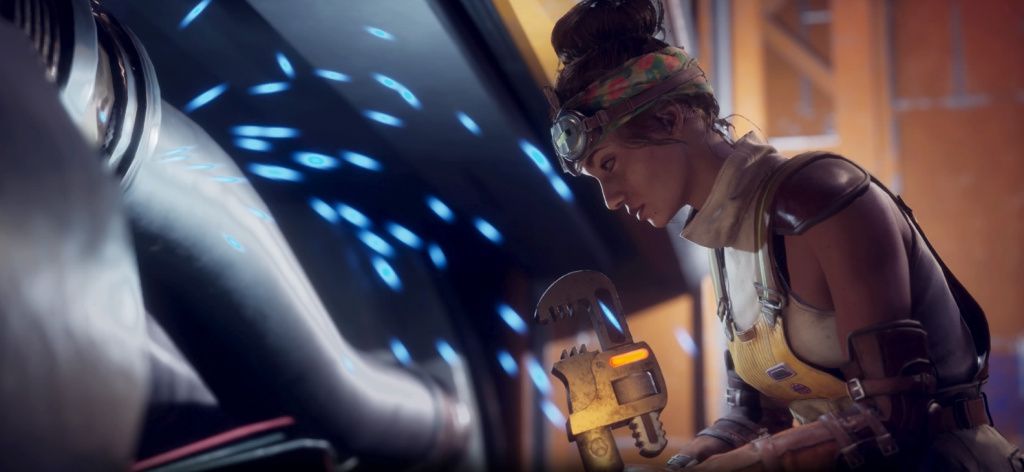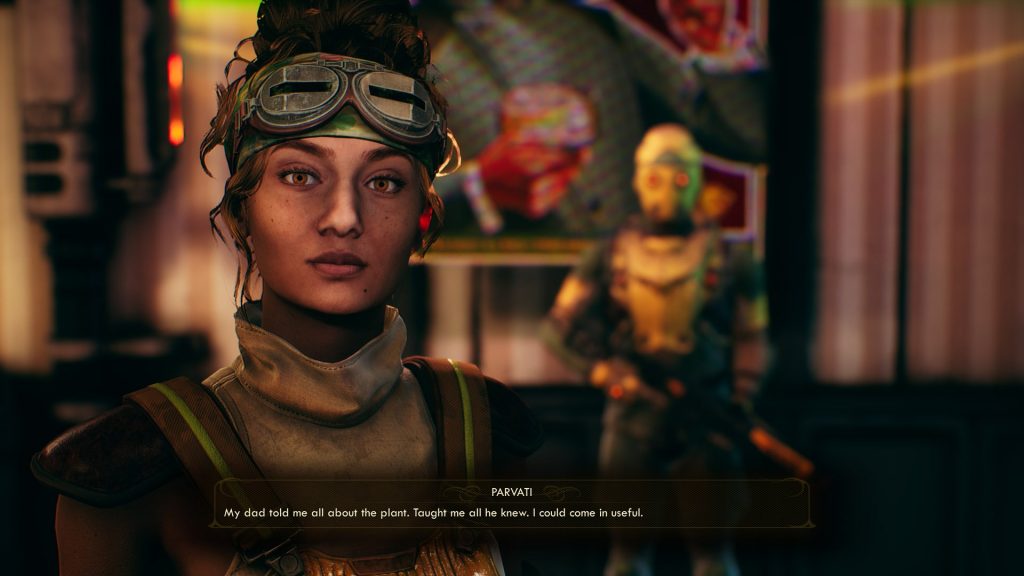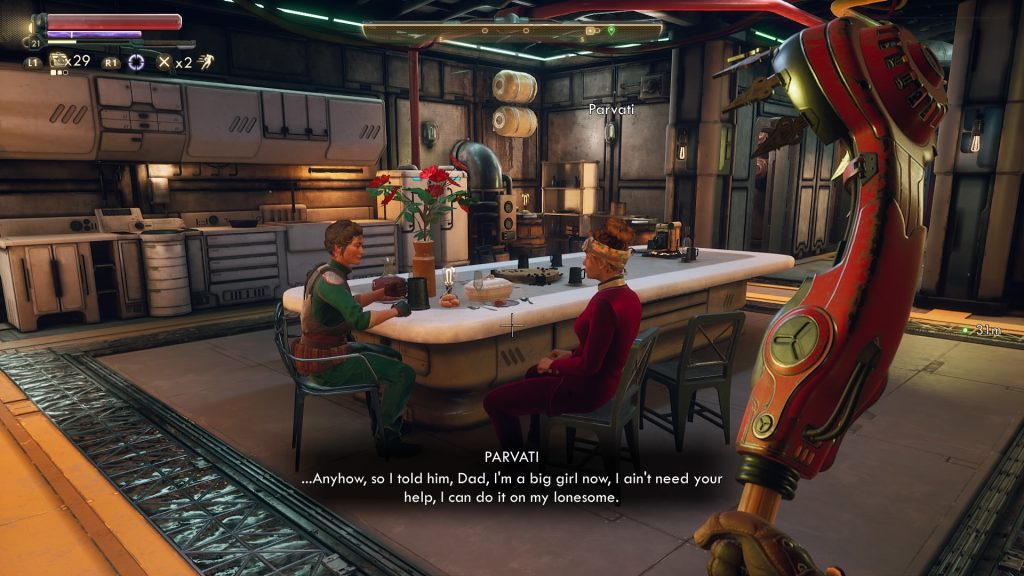
Who Runs The Outer Worlds? Lesbians

Big Bisexual Energy is common parlance when describing video games these days. Final Fantasy VII Remake has it. Fire Emblem: Three Houses has it. Assassin’s Creed: Odyssey has it. You could probably write a whole thesis on what exactly comprises Big Bisexual Energy, but it essentially boils down to everyone in the game, no matter what their gender, being hot. It helps if the game features queer characters, queer coding, easily queered relationships and avoids cishet stereotyping, but Final Fantasy VIII Remake’s BBE can be understood simply showing someone a picture of Cloud and Aerith, just as Fire Emblem’s can be explained by an image of Claude and Shamir.
The Outer Worlds possesses very different energy: Big Lesbian Energy. That doesn’t simply mean the women are hot – several games which lack this energy fit that description and then some – but instead comes from the way The Outer Worlds puts women at the center of its narrative, relies on queer imagery and addresses inclusivity and representation. None of the gunplay, the moral choice storyline, nor the satirisation of capitalism within The Outer Worlds bring anything especially new to the table, but through a combination of steampunk, neoliberalism, Gilded Age dialogue and its Big Lesbian Energy, the world Obsidian have created is a completely unique one.
Just like everything else in The Outer Worlds, the best place to start is Parvati Holcomb. She’s the first companion you meet in the game, and endlessly fascinating in a way only the best RPG squadmates are. She’s also an asexual lesbian, with one of the most heartfelt and compelling romance arcs in modern gaming, eventually dating the Groundbreaker’s chief engineer and captain, Junlei.

The fact we watch this relationship unfold before us rather than actively participating as a love interest ourselves further highlights how this Big Lesbian Energy is sewn into the very fabric of The Outer Worlds. The ways it’s stripped of any ‘forbidden fruit’ angle help ground it further; this relationship is one like thousands within this universe, and is of interest because of the inclusion of the deeply charismatic Parvati, not because it’s two women.
Junlei isn’t the only female character in a leadership position either. The game features so many powerful women. While it’s not surprising in and of itself that several women are competent enough to gain these positions, it is surprising that they are deemed competent enough, both by the game itself and the world it has created. Even today, women in positions of power are frequently underrepresented (even more so for women of colour), so it was refreshing to see so many of them present here. That women have the same approximate number of leadership positions as men are never highlighted within the game, nor is it particularly noticeable. It doesn’t go out of its way to insist on gender equality, nor does it frame the success of these women as being against the odds or as a testament to their strength to overcome the patriarchy.
There’s certainly something to be said for stories which do highlight these angles; many women who have risen to powerful positions in the real world have had to contend with misogyny on their rise; especially for women of colour. But The Outer Worlds is not the real world, and misogyny shouldn’t be so firmly entrenched in our existence as humans that imagining a sci-fi world without it be deemed unrealistic or irresponsible. The Outer Worlds tells you that ‘women are equal here: deal with it’, but it says it without an attitude which would draw attention. It simply is.
I realise that applauding women in positions of power without critically examining how they act in those positions has the same feeling as cheering for the first female general to order a drone strike on an Iranian village. It’s Big Lesbian Energy I’m trying to channel here, not Big Pete Buttigieg/Charlotte Clymer Energy.
The satire of capitalism, terror of bureaucracy, bottomless greed of humanity The Outer Worlds showcases has already been covered several times over though, so for here, let’s keep it brief: some people are bastards, some people are women, ergo some women are bastards. I’m not suggesting we should praise the all of the individual women in this morally grey society of The Outer Worlds simply because they have attained leadership positions, but I am suggesting that the presence of women across the spectrum, including providing villains to be reviled, is an important part of how this game constructs its unique reality.

Having lots of women and ‘oh yeah, Parvati and Junlei are lesbians’ does not Big Lesbian Energy make, however. It’s the way the game marries these concepts together which drives the point home.
Several of these characters are queer coded in their design, something which becomes even more noticeable when you play as a non-male character. Though short hair = lesbian is a very reductive reading, we can’t get away from the fact that so many of the women within The Outer Worlds have punk undercuts with short, ruffled hair. Yes, this is probably to save both file size and the cost of character designs. But where most AAA games either only hint at queer representation or feature tokenistic side characters, giving us a whole universe filled with muscular, short-haired, confident women felt like a fresh idea and a welcome escape from the norm, even if it wasn’t entirely intentional.
As for playing as a non-male, the biggest difference when dealing with male and female NPCs is how the Charm skill works. For men, it usually means complimenting or flattering them, whereas with women it more often that not leans into casual flirting. Again, this is likely unintentional and even a heteronormative cue that the game was written to be played by a default male character. However, playing as a woman highlights the Big Lesbian Energy which glows throughout The Outer Worlds. Whether it was supposed to be there or not, whether it was supposed to be interpreted this way or not, there’s something uniquely special about how The Outer Worlds plays out.
The game was supposed to teach us that capitalism is bad. But it also taught us that lesbians are great. Which really, you should have known already.








Comments are closed.